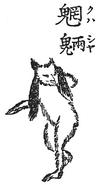>Mt.kiki |
>Mt.kiki |
| Line 55: |
Line 55: |
|
| |
|
| http://yumenikki.wikia.com/wiki/Number_World(name)#The_Stabbing_Room.28Mount_Fuji.29 | | http://yumenikki.wikia.com/wiki/Number_World(name)#The_Stabbing_Room.28Mount_Fuji.29 |
|
| |
|
| |
| ==[[The Dense Woods]] ([[List_of_Characters#.28Unnamed.29_5|Kimajo]])==
| |
| Harpies remained vivid in the Middle Ages.
| |
|
| |
| [[File:Kimajo_ch.jpg|thumb|The Wood of the Self-Murderers:]]In his Inferno, XIII, [http://en.wikipedia.org/wiki/Dante <u>Dante</u>] envisages the tortured wood infested with harpies, where the [http://en.wikipedia.org/wiki/Suicide <u>suicides</u>] have their punishment in the seventh ring of Hell:
| |
|
| |
| http://en.wikipedia.org/wiki/Harpy
| |
|
| |
|
| |
| Here the repellent harpies make their nests,
| |
| Who drove the Trojans from the Strophades<br />With dire announcements of the coming woe.<br />They have broad wings, a human neck and face,
| |
| Clawed feet and swollen, feathered bellies; they caw<br />Their lamentations in the eerie trees.<sup class="reference" id="cite_ref-6" sizcache09779979311431767="68 141 69" sizset="false">[http://en.wikipedia.org/wiki/Harpy#cite_note-6 <u>[6</u>]]</sup>
| |
|
| |
| [http://en.wikipedia.org/wiki/William_Blake <u>William Blake</u>] was inspired by Dante's description in his pencil, ink and watercolour "[http://en.wikipedia.org/wiki/The_Wood_of_the_Self-Murderers:_The_Harpies_and_the_Suicides <u>The Wood of the Self-Murderers: The Harpies and the Suicides</u>]" (Tate Gallery, London)
| |
|
| |
|
| |
| [[File:Toriningen_all_anim_lunatic.gif|thumb|Harpy three sister?]]
| |
|
| |
| ==[[Toriningen]] ([http://en.wikipedia.org/wiki/Harpy Harpy])==
| |
|
| |
| In [http://en.wikipedia.org/wiki/Greek_mythology <u>Greek mythology</u>], a harpy ([http://en.wikipedia.org/wiki/Greek_language <u>Greek</u>]: ἅρπυια, ''harpyia'', pronounced [http://en.wikipedia.org/wiki/Help:IPA_for_Greek <u>[hárpuja</u>]]; [http://en.wikipedia.org/wiki/Latin_language <u>Latin</u>]: ''harpeia'') was one of the winged spirits best known for constantly stealing all food from [http://en.wikipedia.org/wiki/Phineus <u>Phineus</u>]. The literal meaning of the word seems to be "that which snatches" as it comes from the Greek word ''harpazein'' (ἁρπάζειν), which means "to snatch".
| |
|
| |
| [[File:The_Jump.png|thumb|The Harpies(toriningen) and the Suicides(madotsuki)]]
| |
|
| |
|
| |
|
| |
|
| |
|
| |
|
| |
|
| |
|
| |
|
| |
|
| |
|
| |
|
| |
| [[File:Witch's_Island(Witch).png|thumb|Dress and hair which hang over the wind from the east.
| |
| ]]
| |
|
| |
| ==[[Witch's Island]]([http://en.wikipedia.org/wiki/Zephyros#West_wind Anemoi])==
| |
| ※Dress and hair which hang over the wind from "the East([http://en.wikipedia.org/wiki/Zephyros#West_wind Anemoi]?)".
| |
|
| |
| Added by [http://www.youtube.com/user/pumoo?feature=watch <u>pumoo milk</u>]
| |
|
| |
|
| |
| http://www.youtube.com/watch?v=d96T6J38Dhc
| |
|
| |
|
| |
|
| |
| [http://en.wikipedia.org/wiki/Zephyros#Eurus <u>3 Eurus</u>]
| |
|
| |
| Eurus ([http://en.wikipedia.org/wiki/Greek_language <u>Greek</u>]: Εύρος, ''Eúros'') was the Greek deity representing the unlucky [http://en.wikipedia.org/wiki/East_wind <u>east wind</u>]. He was thought to bring warmth and rain, and his symbol was an inverted vase, spilling water. His Roman counterpart was '''Vulturnus''' (not to be confused with [http://en.wikipedia.org/wiki/Volturnus <u>Volturnus</u>], a tribal river-god who later became a Roman deity of the River [http://en.wikipedia.org/wiki/Tiber <u>Tiber</u>]).
| |
|
| |
| [http://ja.wikipedia.org/wiki/%E3%82%A2%E3%83%8D%E3%83%A2%E3%82%A4#.E4.B8.8A.E4.BD.8D.E3.81.AE.E3.82.A2.E3.83.8D.E3.83.A2.E3.82.A4 <u>1 上位のアネモイ</u>]
| |
| *[http://ja.wikipedia.org/wiki/%E3%82%A2%E3%83%8D%E3%83%A2%E3%82%A4#.E6.9D.B1.E9.A2.A8.E3.82.A8.E3.82.A6.E3.83.AD.E3.82.B9 <u>1.3 東風エウロス</u>]
| |
| <p class="toclevel-2 tocsection-4">'''エウロス'''(Εύρος, Euros)は、不吉な[http://ja.wikipedia.org/wiki/%E6%9D%B1 <u>東</u>]風を表す神である。エウロスは暖気と雨を運んでくる神と考えられており、さかさまになって水をこぼしている壺がエウロスの象徴であった。</p>
| |
|
| |
| ローマ神話においてエウロスに相当する神格は'''ウルトゥルヌス''' (Vulturnus) であった。
| |
|
| |
| ==[[Witch's Island]]([http://en.wikipedia.org/wiki/Witch-hunt Witch-hunt])==
| |
| ※The nose at Which([http://en.wikipedia.org/wiki/Witch-hunt Witch-hunt]?) the White-skin witch was displeased is "a beak([http://en.wikipedia.org/wiki/Ural_Owl Ural Owl]?)"
| |
|
| |
| [[File:Strix_uralensis.jpg|thumb|Ural Owl in Prague Zoo]]
| |
|
| |
| [http://ja.wikipedia.org/wiki/%E9%AD%94%E5%A5%B3%E7%8B%A9%E3%82%8A#.E3.83.A8.E3.83.BC.E3.83.AD.E3.83.83.E3.83.91.E3.81.AB.E3.81.8A.E3.81.91.E3.82.8B.E9.AD.94.E5.A5.B3.E7.8B.A9.E3.82.8A <u>1 ヨーロッパにおける魔女狩り</u>]
| |
| 女性研究家[http://ja.wikipedia.org/w/index.php?title=%E3%83%9E%E3%83%83%E3%82%AF%E3%82%B9%E3%83%BB%E3%83%80%E3%82%B7%E3%83%A5%E3%83%BC&action=edit&redlink=1 <u>マックス・ダシュー</u>](Max Dashu)によれば、中世の人々が持っていた魔女観はキリスト教以前の社会にさかのぼるものも見られるという。たとえばローマの民族宗教であった[http://ja.wikipedia.org/wiki/%E3%83%90%E3%83%83%E3%82%AF%E3%82%B9_(%E3%83%AD%E3%83%BC%E3%83%9E%E7%A5%9E%E8%A9%B1) <u>バッカス</u>]信仰やローマの伝説に出る怪物[http://ja.wikipedia.org/w/index.php?title=%E3%82%B9%E3%83%88%E3%83%AA%E3%82%AF%E3%82%B9&action=edit&redlink=1 <u>ストリクス</u>](女性の姿をし、[http://ja.wikipedia.org/wiki/%E3%81%B5%E3%81%8F%E3%82%8D%E3%81%86 <u>ふくろう</u>]に化けて空を飛ぶとされた)と魔女像との関係が指摘されている。
| |
|
| |
|
| |
|
| |
| For example, the relation of monster [http://ja.wikipedia.org/w/index.php?title=%E3%82%B9%E3%83%88%E3%83%AA%E3%82%AF%E3%82%B9&action=edit&redlink=1 <u>ストリクス</u>] (it was presupposed that a female figure was carried out, it was changed into an [http://en.wikipedia.org/wiki/Ural_Owl owl], and it flew in the sky) and the witch image which appear in the tradition of the [http://en.wikipedia.org/wiki/Bacchanalia Bacchus] faith which was the race religion of Rome, or Rome is pointed out.
| |
|
| |
| ==[[Witch's Island]]([http://en.wikipedia.org/wiki/Ural_Owl Ural Owl])==
| |
| ※[[Madotsuki]] havn't her mother, If it passed away in a certain accident and childbirth?
| |
|
| |
| http://yumenikki.wikia.com/wiki/Hell(name)#Hell.28Caesarean_section.29
| |
|
| |
| [http://ja.wikipedia.org/wiki/%E3%81%B5%E3%81%8F%E3%82%8D%E3%81%86#.E4.BA.BA.E9.96.93.E3.81.A8.E3.81.AE.E9.96.A2.E4.BF.82 <u>5 人間との関係</u>]
| |
|
| |
| 日本と中国では、梟は母親を食べて成長すると考えられていた為「不孝鳥」と呼ばれる。[http://ja.wikipedia.org/wiki/%E6%97%A5%E8%93%AE <u>日蓮</u>]は著作に於いて何度もこの点を挙げている<sup class="reference" id="cite_ref-1">[http://ja.wikipedia.org/wiki/%E3%81%B5%E3%81%8F%E3%82%8D%E3%81%86#cite_note-1 <u>[1</u>]]</sup>。
| |
| *[http://ja.wikipedia.org/w/index.php?title=%E9%96%8B%E7%9B%AE%E6%8A%84&action=edit&redlink=1 <u>開目抄</u>] 譬へば幼稚の父母をのる、父母これをすつるや。梟鳥が母を食、母これをすてず。破鏡父をがいす、父これにしたがふ。畜生すら猶かくのごとし
| |
| In Japan and China, since it was thought that a mother was eaten and it grew up "an undutiful bird", 梟 is called.<br />Nichiren is mentioning this point in writing repeatedly [1].
| |
|
| |
| ==[[Witch's Island]]([http://en.wiktionary.org/wiki/sink_or_swim Sink or Swim])==
| |
| [[File:Witch's_Island(sink_or_swim).png|thumb|Witch's Island(Sink or Swim)]]
| |
| [http://en.wiktionary.org/wiki/sink_or_swim#English <u>1 English</u>]
| |
| *[http://en.wiktionary.org/wiki/sink_or_swim#Etymology <u>1.1 Etymology</u>]
| |
| *[http://en.wiktionary.org/wiki/sink_or_swim#Verb <u>1.2 Verb</u>]
| |
|
| |
| ===Etymology===
| |
| Possibly from the practice of throwing a suspected witch into water.
| |
| ===Verb [[http://en.wiktionary.org/w/index.php?title=sink_or_swim&action=edit§ion=3 <u>edit</u>]]===
| |
| [http://en.wiktionary.org/wiki/sink <u>sink</u>] or [http://en.wiktionary.org/wiki/swim <u>swim</u>]
| |
| #([http://en.wiktionary.org/wiki/Appendix:Glossary#idiomatic <u>idiomatic</u>]) To [http://en.wiktionary.org/wiki/fail <u>fail</u>] or [http://en.wiktionary.org/wiki/succeed <u>succeed</u>], no matter what.
| |
|
| |
|
| |
|
| |
|
|
| |
|
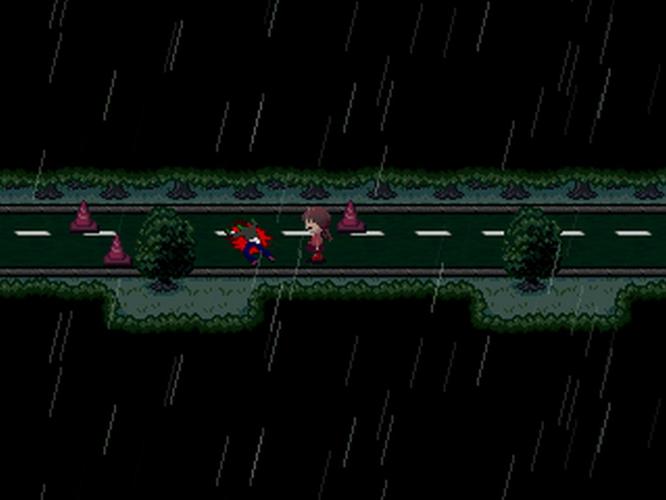
The Dence Woods(The Wood of the Self-Murderers: The Harpies and the Suicides)
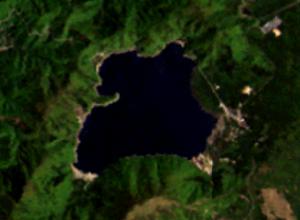
The northeast side in Lake Motosu is Aokigahara.
※Name of 「樹海」 is debug name that "Yumenikki Map File"
樹海(じゅかい)
Ocean of foliage
- It is a vast forest like the sea.Aoki-hara (ocean-of-foliage of the Mt.Fuji) is famous in Japan.
- Slang which points out the thing in a mountain or woods which commits suicide from Aoki-hara being made into the famous place of suicide.
※Relevance with "The Wood of the Self-Murderers: The Harpies and the Suicides"
http://yumenikki.wikia.com/wiki/The_Dense_Woods(name)#The_Dense_Woods.28Kimajo.29
Developer(s) - OutSide Directors Company
Platform(s)PlayStation, PSN
『LSD (video game) 』 Release date(s) - JP October 22, 1998
http://en.wikipedia.org/wiki/LSD_(video_game)_
※Relevance with "Mt. Fuji of Yumenikki" of " Mt.Fuji of LSD (game)".
http://yumenikki.wikia.com/wiki/Number_World(name)#The_Stabbing_Room.28Mount_Fuji.29
※It seems that a "green skin" originates in a "Green walking-man", "Red blood" originates in a "Red light".

"Green Walking-man" became "red(blood)-Light" and "Stopped(life)"?
2 Types 2.4 Pedestrian and cyclist crossing lights 2.4.4 British standard
British standard
In the United Kingdom, British Crown Dependencies and dependent territories, and former possessions like Hong Kong:
- Green walking-man: Cross with caution (pedestrians have the right of way; motorists turning left or right must yield to pedestrians
- Flashing green walking-man: Continue to cross if already in the intersection, but do not start to cross
- Red/Orange standing-man: Do not cross
12 その他
※ "Blue jeans" originates in a Japanese "青信号(green/blue) light".
日本では緑色表示を「緑信号」ではなく「青信号」と表現されている。
In Japan, the green display is expressed as the "Blue signal" instead of a "Green signal."
これは戦前、信号機が日本に初めて導入された際、マスメディアが「緑信号」を「青信号」と表現したことによるものである。
This is because the mass media expressed the "Green signal" as the "Blue signal", when a signal is introduced into Japan for the first time prewar days.
※"Madotsuki(Cat)" is a "Kasha(burning chariot)" on the "Road"?

Madotsuki(火車猫)
Kasha (火車?, lit. "burning chariot" or "burning barouche") is the name of a being from Japanese mythology, belonging to the higher range of demons, the Yōkai. The belief in Kashas is rooted in Shintoism and Buddhism.
1 Description
Japanese folklore describes the Kasha as humanoid cat-demons with the head of a cat or tiger and a burning tail. They are similar to other demons such as Nekomata and Bakeneko and get often interchanged with them.
File:Yumenikki(Shitai-san) - Madotsuki(Cat) 2009年07月16日 22:26 "【ゆめにっき】よし、死体さんに会いに行こう。" #6:26~6:42 Added by "さんすう" 4 考察 ("not bringing a cat close to a dead person" and "the dead body in a coffin rising if a cat jumps over a coffin top.")
※"Madotsuki(Cat)" is a "Kasha(humanoid cat-demons)",it is there is relation with a "dead person(Shitai-san)".
4 考察
日本古来では猫は魔性の持ち主とされ、「猫を死人に近づけてはならない」「棺桶の上を猫が飛び越えると、棺桶の中の亡骸が起き上がる」といった伝承がある。
In Japanese ancient times, a cat is made into the owner of devilism and there is tradition of "not bringing a cat close to a dead person" and "the dead body in a coffin rising if a cat jumps over a coffin top."
また中世日本の説話物語集『宇治拾遺物語』では、獄卒(地獄で亡者を責める悪鬼)が燃え盛る火の車を引き、罪人の亡骸、もしくは生きている罪人を奪い去ることが語られている。
Moreover, by the collection "Uji shui monogatari" of tale tales of Japan, the car of the fire with which 獄卒 (悪鬼 which blames the dead in hell) burns vigorously is pulled, a sinner's dead body or a living sinner is taken, and last thing is told medieval times.
火車の伝承は、これらのような猫と死人に関する伝承、罪人を奪う火の車の伝承が組み合わさった結果、生まれたものとされる[1]。
The tradition of 火車 should be produced as a result of the tradition about these cats and dead persons and the tradition in straitened circumstances which takes a sinner combining [1].
※Possibly, he was killed in accident noting that the body would help the cat (the life was claimed by the cat)?
※The "red corn" on the street has suggested the deadlock of life?
7 Art-based assessments 7.4 Road drawing
Road drawing
In this drawing assessment and therapeutic intervention, the patient is asked to draw a road. This is a projective assessment used to create a graphic representation of the person's "road of life." The road drawing has the potential to elicit spontaneous imagery that represents the client's origins, the history of his or her life process, experiences to date, and intent for the future - even from a single drawing (Hanes, 1995, 1997, 2008). The road's reparative features or its need for "periodic upgrade" can serve as a metaphor for the client's capacity for change and restoration (Hanes, 1995, 1997, 2008).

"Spirited Away (Japanese: 千と千尋の神隠し)"(July 20, 2001)
※"Spirited Away" is no train of return.
釜爺の「間違えるなよ。昔は戻りの電車があったんだが、近頃は行きっぱなしだ」という台詞。
釜爺 "don't mistake.Although there was a train of return a long time ago, it only goes recently"
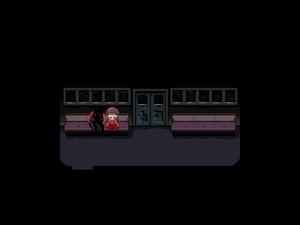
Inside the train car with black man.
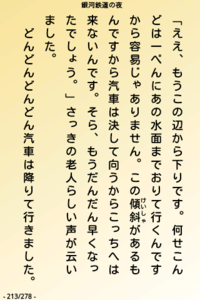
Night_on_the_Galactic_Rainroad(Page213~278)
※"Night on the Galactic Rainroad" is no train of return.
銀河鉄道の夜(Night on the Galactic Rainroad)
「・・・この傾斜があるもんですから汽車は決して向うからこっちへは来ないんです。」
"... a train never comes here from the other side because of this inclination."
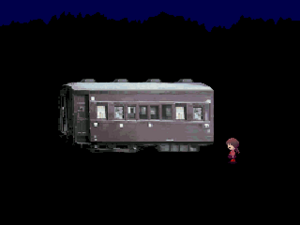
"Yumenikki" is no train of return.
※It is not a steam locomotive(Galactic Train) but a train(Spirited Away's Train).
http://yumenikki.wikia.com/wiki/Mars(name)#Final_Destination.28Night_on_the_Galactic_Railroad.29





